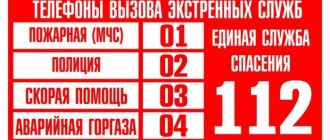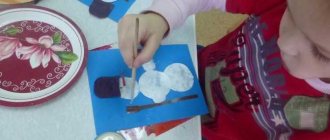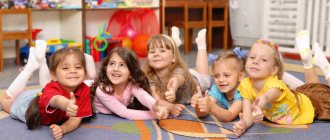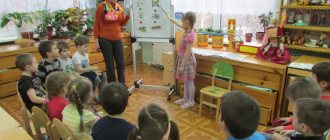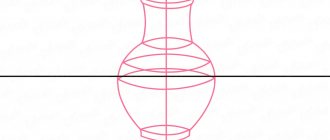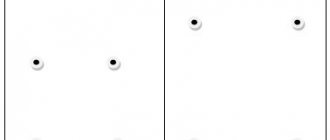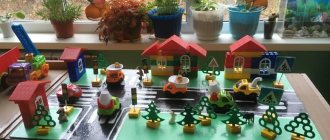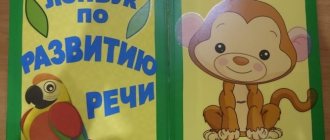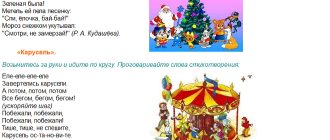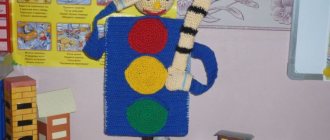What is a traffic rules lapbook for preschoolers
The concept of lapbook is made up of two English words: lap (lap) + book (book). Such an interactive educational book is needed to collect and organize information on any topic. Each lapbook is individual. Its structure can be arbitrary, depending on the wishes of the child and his level of knowledge on the topic.
The main advantages of such a book for a child:
- Attractive appearance that arouses interest and is an incentive to study the content.
- A large amount of information presented in a concise form that is easy to learn and remember.
Typewriter folder created by preschool students
The traffic rules lapbook for kindergarten is designed to familiarize pupils of different age groups with traffic rules, signs and symbols on the road, illustrate examples of dangerous and safe behavior near the roadway, help the child learn these rules and not get confused on the spot. In a kindergarten, a lapbook can be made in the form of a common stand or folder for each child.
Lapbook on traffic rules in preschool educational institutions: production
The basis of the reference lapbook is created by the teacher, and the structure and individual elements are created by the child together with parents, teachers from the kindergarten and other children. With the help of a colorful lapbook, a child can easily understand, structure and remember important definitions and rules, and learn previously learned material. The basis of a lapbook can be a cardboard folder for storing documents or a folded sheet of cardboard.
Elements of the internal content of the manual can be printed in the form of templates or made independently. The inside of the folder in the form of 2-3 sheets of A3 or A4 format is covered with colored paper or scrapbooking paper. Pockets, mini-books, notebooks, etc. are glued in any form. It is advisable to place important traffic rules in a separate envelope, and fill other elements of the folder with riddles, puzzles, poems and games.
Additional Information! The cover and title page of the laptop can be decorated with a thematic picture or drawing, or 3D applique. Inside the folder you can stick decorative elements in the form of figures made of felt or paper.
Content
During the creation and filling of a lapbook, the child demonstrates his creative abilities, aesthetic taste, applies theoretical skills acquired in class, groups materials according to certain characteristics, and better understands and remembers information.
Didactic manual with various elements
A lapbook on traffic rules in a preschool educational institution may contain the following:
- cards;
- envelopes (standard, curly) and pockets;
- houses with opening shutters;
- photographs and drawings;
- diagrams and tables;
- small books (with pages and accordions);
- moving elements (rotating circles).
Examples of lapbooks on traffic rules
Before starting to work on a lapbook, you need to outline what the child should learn and master in the process of studying with the book, which elements to place, in what sequence.
For example:
- Rules of conduct for a preschooler on the road and near the roadway;
- road signs and indicators;
- types of vehicles;
- familiarization with the traffic controller's uniform and his tools;
- poems dedicated to traffic rules;
- traffic rules quiz;
- thematic riddles.
How to teach your child to memorize numbers and their spelling
Note! Rules of behavior on the road can be presented in poetic form, easy and exciting for a child.
Draw vehicles on the cards. The child must distribute them into pockets, each containing a specific type of transport (special equipment, land, railway, air, water). The goal is to develop classification skills and introduce new concepts.
To get acquainted with road signs and pointers, the child can be asked to color their images, solve riddles and puzzles. Print the text of the riddle on each card. Also prepare cards with images - answers. Distribute all materials into envelopes. The teacher reads the text of the riddle, and if the child answers correctly, shows a picture.
This activity contributes to the following:
- memory training;
- development of intelligence;
- mastering traffic rules in a playful way.
On one of the sheets you can place a colorful image of a traffic controller with a description of the elements of his uniform and tools (rod and whistle), and give a poem about a representative of this profession. The quiz can be about traffic rules, traffic signals, road signs or markings.
Example of a colorful leaflet
Materials
To make a training knee book you will need the most accessible materials:
- A3 or A4 folder;
- cardboard;
- scrapbooking paper;
- white and colored paper;
- felt;
- paper glue;
- scotch;
- markers;
- watercolor paints and felt-tip pens;
- stapler;
- safety scissors.
Important! During the work, the child must use materials and tools under the supervision of an adult.
Creative materials
Progress of the game:
Children choose the signs of their group and tell which signs they chose.
1-our prohibiting signs: “Parking prohibited”
,
"
Pedestrian traffic is prohibited " ,
"
Bicycle traffic .
2—our warning signs: “Slippery road ”
,
"Sharp Turn"
,
"
Road Works " .
3—our prescriptive signs: “Pedestrian crossing”
,
“Bus stop location”
,
“Residential area”
.
4—our service marks: “Hospital”
,
"Telephone"
,
"
Gas Station " .
Didactic game “Guess what sign”
Target:
1. Fix the names and purpose of road signs .
2. Be able to determine which signs are for drivers and which are for pedestrians.
3. To develop attention and skills of conscious use of knowledge about road signs in everyday life.
Description of lapbooks
The content of the knee books depends on the age and level of training of the student.
For middle groups 4-5 years old
The purpose of the traffic rules lapbook for middle groups of preschool educational institutions is to introduce preschoolers to the rules of the road for pedestrians and drivers, the components of the road, road signs and indicators for all road users.
Important! The manual is designed to arouse the child’s interest in the topic and introduce important rules in a familiar playful way.
In the process of working with a lapbook, the child will train and develop speech, memory, and communication with other team members.
The folder may contain the following sections:
- cards with traffic rules;
- types of transport in pictures;
- poems about traffic rules;
- simple riddles (texts + pictures);
- labyrinths (to build a safe path from home to preschool educational institution);
- coloring cards (road sign, vehicle);
- thematic puzzles from several parts;
- games with elements of physical activity.
It is better to place cards with traffic rules in a pocket, in the central part of the book. The purpose of this section is to consolidate a young child’s knowledge of traffic rules, convey information about the need to be vigilant and careful near a highway, not to get lost and clearly know how and where to cross the roadway. The purpose of riddles on the topic is to develop intelligence, the ability to correlate a text description and an image of an object, and enrich speech.
The essence of the game “labyrinths” is to create a safe route from point A to point B using chips or fingers with the child’s comments. The goal is to develop intelligence, logic, attention, fine motor skills, and speech.
Didactic games for preschool age in preschool educational institutions
Note! To make the lesson more effective, you should change the type of activity.
For example, you can arrange a game between two teams: drivers and pedestrians. The teacher or student takes a blank from the envelope - traffic signals and shows one of the images. Depending on the color, the participants in the game walk or stand still. The goal is to develop memory, reaction speed, and coordination of movements.
For older groups 5-6 years old
Note! The goals of creating a kneeling book for children 5-6 years old are to systematize knowledge on the topic, convey the importance of traffic signals, teach how to classify road signs, develop attention, independence, and caution.
Envelopes with tasks and games in accordance with the age of preschool children:
- meaning of traffic lights;
- road signs and their meaning;
- types of transport (classify, find the odd one out);
- puzzles;
- coloring books (consolidating knowledge on the topic, developing fine motor skills, accuracy);
- poems on the topic of traffic rules;
- puzzles and crosswords;
- questions (to determine the correctness/incorrectness of actions on the road);
- puzzles;
- game “situations on the road” (the teacher voices the situation, and the children act it out on a model of the road using toy men or animals);
- left-right (arrange vehicle printouts according to the direction of travel);
- find differences (up to 10 positions);
- outdoor game (children perform certain actions at the traffic light signal);
- visual information (selection of educational videos and cartoons on the topic of traffic rules).
For preparatory groups 6-7 years old
Pupils of preparatory groups can not only improve their knowledge in the field of traffic rules, but also actively participate in the collection and systematization of information.
The purpose of creating a thematic folder is to consolidate acquired knowledge, awareness of the importance of safe behavior on and near the road, readiness to cross the roadway at both regulated and unregulated crossings, teach how to prevent dangerous situations and clearly act when necessary. You can include all of the above elements in the manual, complicating them and diversifying the content.
Important! Thanks to the attractive appearance and thoughtful structure of the lapbook, children can easily and in a relaxed manner expand their knowledge base.
Folder for older children
LEPbook “Road Rules” for preschool children
“Make a picture.”
Parts of pictures are glued onto three cubes measuring 5*5*5, from which you need to make pictures in a column.
Target:
Develop visual attention, intelligence, enrich vocabulary.
- Second cube
It is made of felt. Each side depicts types of ground transportation.
"Put the puzzle together."
One side of the cube is in the form of cut puzzle strips with Velcro.
"Put out the fire."
On this side of the cube there is a picture of a burning house (pull the rope up - a fire appears, put it out - then you have to pull the rope down), a fire truck with a ladder and a hose for extinguishing the fire; the ladder and wheels unfasten and fasten.
"On guard of order"
On the other side is an image of a traffic police car, where the wheels are fastened and unfastened; There is a clasp, when you unfasten it, flowers appear from there.
"Cars on a city street"
Here cars move on a string.
"Truck"
carries a load (geometric shapes), the wheels are fastened and unfastened.
"Bus"
made of felt, wheels can be fastened and unfastened, doors with laces.
Target:
Develop the ability to make a whole from parts. Fix the types of transport, their purpose, fix the PPB. Develop fine motor skills of the hands: the ability to fasten and unfasten a button, lock, move along a rope, pull a rope, lace. Learn the names of geometric shapes.
- Third cube
. Made of cardboard, covered with printed drawings with the name of each game. There's a game in every pocket. The inside of the cube is also designed in the form of a city street with markings.
Didactic game “Situations on the city streets.”
The game is located in the pocket of the third cube. Here are collected plot pictures with various situations on the roads.
Target:
To create conditions for activating the mental and cognitive activity of children in the process of studying material on the topic “Traffic Rules” through solving problem situations.
"The traffic light makes riddles."
The riddle sheets are in the pocket in the third cube. The mysteries change.
Target:
develop mental abilities and visual perception; learn to correlate the verbal form of description with their graphic representation; cultivate independence, speed of reaction, and ingenuity.
"Traffic signs".
The signs are printed and placed in the pocket of the third cube.
Target:
Learn the names and purpose of road signs; be able to determine which signs are for drivers and which for pedestrians; develop attention and skills for conscious use of knowledge about road signs in everyday life.
"Rebuses".
This pocket contains printed puzzle pictures.
Target:
Activate mental and cognitive activity.
“Color the picture” (coloring pages according to traffic rules).
Coloring drawings are printed on separate sheets of paper and are located in the pocket of the third cube. They are on topic and constantly changing.
Target:
Learn to color pictures without going beyond the contours, learn to hold a pencil (felt-tip pen) correctly; establish traffic rules for pedestrians and drivers.
"Poems about road signs."
The poems are collected on separate sheets and placed in the pocket of the third cube.
Target:
help children remember and learn traffic signs in poetic form.
Cube unfolded “Place signs on the road.”
Signs are used for the game. Task: place signs correctly on certain sections of the road.
Target:
consolidate knowledge of road signs and their purpose; teach to explain where and what sign should be.
Recommendations for use:
The didactic manual “Road Rules” is recommended for use in working with children, children in independent and play activities.
Thanks to this form of work, children will learn a lot about traffic rules, learn and enjoy reading poems about road signs by heart, come up with riddles about traffic rules, and learn the rules of the road. Working with an LEPbook will allow you to diversify your work and increase children's cognitive interest. I think our children will like our LEPbook and we will often use it in our work.
Bibliography
- Danilova T.I. Program “Traffic Light” Teaching preschool children traffic rules. - St. Petersburg, publishing house "CHILDHOOD-PRESS", 2009.
- Kozlovskaya E. Road traffic accidents involving preschool children. Causes and conditions contributing to their occurrence // Preschool education. 2011. No. 10.
- Traffic Laws. Senior and preparatory groups. / Comp. Poddubnaya L. B. - Volgograd: ITD "Corypheus".
- Skorolupova O. A. Classes with children of senior preschool age on the topic “Rules and road safety.” - M., 2007.
- Saulina T. F. Three traffic lights: Introducing preschoolers to the rules of the road - M.: Mozaika-Sintez, 2008.
- Khromtsova T. G. Education of safe behavior of preschoolers on the street: Textbook - M.: Center for Pedagogical Education, 2007.


